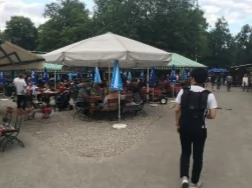CLEO/Europe-EQEC 2017 Shun Fujii
Research
CLEO/Europe-EQEC 2017 Participation Report
Master2Year: Shun Fujii
About the Conference
I attended CLEO/Europe-EQEC 2017 held in Munich, Germany, from June 25 to 29. CLEO/Europe is a biennial conference focusing on optoelectronics and is a sister conference of CLEO, which is held annually in San Jose, California, USA. Since the conference is held in Germany, there were more participants from Europe compared to CLEO. Although there were a fair number of sessions and presentations on optical com-munications, some of them were not so new, as some of them were presented at CLEO held in the U.S. and some of them had already been published. Compared to the CLEO I attended last year, the participants seemed to be somewhat more relaxed, and the questions were not as active. The sun sets around 9:30 p.m. in Germany at this time of the year, and it is light until late at night every day, making the day seem much longer. On fine days, we were blessed with opportunities to eat outdoors in beer gardens and enjoyed German specialties such as sausages and potato dishes. Despite being in an inland area, we were also able to eat fish dishes such as mackerel and catfish, which were surprisingly? They were very tasty.
2. presentation of own presentation and introduction of research trends
I presented a review of my research at the KEIO-TUM Joint Seminar held at the Technical University of Munich, and it was good to have some discussions with members of the group working on micro optical resonators at the poster room of CLEO Europe. In the Joint Seminar, I listened to a series of presentations on spintronics, but it was difficult for me to understand them due to lack of prerequisite knowledge if I am not a specialist. It may be necessary to learn various fields widely and shallowly when participating in domestic conferences such as the Japan Society of Applied Physics. In many cases, the contents of presentations by well-known groups have already been published or are available on arXiv, so you can check the details of any presentation that interests you immediately. It was clear from the presentations that microcomputers are superior in terms of integration and cost, but inferior in terms of stability and controllability compared to conventional optical comb light sources, and that researchers in this field are aware of this as a common problem. In particular, T. Herr mentioned four points as "Soliton challenge": Stable, Deterministic (number of soliton), Controllable (repetition rate The "soliton challenge" is expressed in the four points: Stable, Deterministic (number of solitons), Controllable (repetition rate), and Efficient. Against this backdrop, there have been several publications such as an innovative method to overcome these problems by using optical pulses as excitation light (T. Herr, EF-3.4), a method to control the number of solitons (H. Guo, EF3.2), and a study on the stabilization of dark solitons, which are considered to be relatively efficient (A. Fullop. CD-P.45), CD-P.45). On the other hand, I had the impression that some of the more theoretical groups were conducting slightly fanatical research on super cavity solitons (M. Erkintalo, EF-1.5) and breathing solitons (E. Lucas, EF-3.1). I also saw some research started by young researchers (P. Del'Haye, T. Herr, etc.), who can be regarded as the first generation of microcomputer researchers, at their new affiliated institutions. It is necessary to check their activities in addition to those of Vahala, Kippenberg, Lipson & Gaeta, and others.


- Categories
- 国際会議報告


